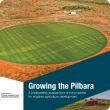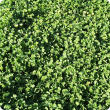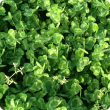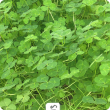Crops
The Department of Primary Industries and Regional Development continues to support the growth and international competitiveness of all crop industries in Western Australia.
With a 2400 kilometre span from its tropical north to its temperate south, WA supports a broad range of cropping industries from rain-fed winter cereals through to irrigated horticultural crops.
In the 2012/13 year the WA cropping industries exported a total of $3.9 billion which comprised: $3.1 billion of cereals, $859 million of pulses, pastures and oilseeds, $142 million of horticultural crops. The major contributors to these exports were wheat ($2.7 billion), canola ($756 million), barley ($377 million), lupins ($42 million), carrots at $48 million, oats ($12 million), and strawberries at $5.5 million.
Filter by search
Filter by topic
- (-) Remove Pastures filter Pastures
- Pasture species (53) Apply Pasture species filter
- Climate, land & water (48) Apply Climate, land & water filter
- Pasture management (42) Apply Pasture management filter
- Livestock & animals (34) Apply Livestock & animals filter
- Land use (29) Apply Land use filter
- Livestock management (25) Apply Livestock management filter
- Soils (24) Apply Soils filter
- Livestock species (24) Apply Livestock species filter
- Rangelands (21) Apply Rangelands filter
- Grains (20) Apply Grains filter
- Managing soils (17) Apply Managing soils filter
- Pests, weeds & diseases (15) Apply Pests, weeds & diseases filter
- Resource assessment (12) Apply Resource assessment filter
- Pasture establishment (12) Apply Pasture establishment filter
- Sheep (11) Apply Sheep filter
- Soil nutrients (10) Apply Soil nutrients filter
- Feeding & nutrition (9) Apply Feeding & nutrition filter
- Weeds (8) Apply Weeds filter
- Grains research & development (7) Apply Grains research & development filter
- Dairy cattle (7) Apply Dairy cattle filter
- Irrigated crops (6) Apply Irrigated crops filter
- Production & postharvest (6) Apply Production & postharvest filter
- Measuring and assessing soils (6) Apply Measuring and assessing soils filter
- High rainfall pastures (6) Apply High rainfall pastures filter
- Beef cattle (6) Apply Beef cattle filter
- Livestock research & development (5) Apply Livestock research & development filter
- Horticulture (5) Apply Horticulture filter
- Control methods (5) Apply Control methods filter
- Crop weeds (5) Apply Crop weeds filter
- Lupins (4) Apply Lupins filter
- Wheat (4) Apply Wheat filter
- Diseases (4) Apply Diseases filter
- Water management (4) Apply Water management filter
- Water (4) Apply Water filter
- Climate & weather (4) Apply Climate & weather filter
- Biosecurity & quarantine (4) Apply Biosecurity & quarantine filter
- Biosecurity (4) Apply Biosecurity filter
- Chemicals (4) Apply Chemicals filter
- Plant biosecurity (3) Apply Plant biosecurity filter
- Soil acidity (3) Apply Soil acidity filter
- Pests (3) Apply Pests filter
- Food, export & investment (3) Apply Food, export & investment filter
- Herbicides (3) Apply Herbicides filter
- Barley (3) Apply Barley filter
- Export services (3) Apply Export services filter
- Crop diseases (2) Apply Crop diseases filter
- Agricultural exports (2) Apply Agricultural exports filter
- Canola (2) Apply Canola filter












